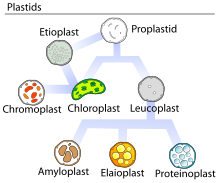

Elaioplasts are one of the three possible forms of leucoplasts, sometimes broadly referred to as such.[1] The main function of elaioplasts is synthesis and storage of fatty acids, terpenes, and other lipids, and they can be found in the embryonic leaves of certain plants, as well as the anthers of many flowering plants.[1][2][3][4]
- ^ a b Wise RR (2007). "The Diversity of Plastid Form and Function". The Structure and Function of Plastids. Advances in Photosynthesis and Respiration. Vol. 23. pp. 3–26. doi:10.1007/978-1-4020-4061-0_1. ISBN 978-1-4020-4060-3.
- ^ Eastmond PJ, Dennis DT, Rawsthorne S (July 1997). "Evidence That a Malate/Inorganic Phosphate Exchange Translocator Imports Carbon across the Leucoplast Envelope for Fatty Acid Synthesis in Developing Castor Seed Endosperm". Plant Physiology. 114 (3): 851–856. doi:10.1104/pp.114.3.851. PMC 158371. PMID 12223747.
- ^ Gleizes M, Pauly G, Carde JP, Marpeau A, Bernard-Dagan C (November 1983). "Monoterpene hydrocarbon biosynthesis by isolated leucoplasts of Citrofortunella mitis". Planta. 159 (4): 373–81. Bibcode:1983Plant.159..373G. doi:10.1007/BF00393177. PMID 24258236.
- ^ van Wijk KJ, Kessler F (April 2017). "Plastoglobuli: Plastid Microcompartments with Integrated Functions in Metabolism, Plastid Developmental Transitions, and Environmental Adaptation". Annual Review of Plant Biology. 68 (1): 253–289. doi:10.1146/annurev-arplant-043015-111737. PMID 28125283.